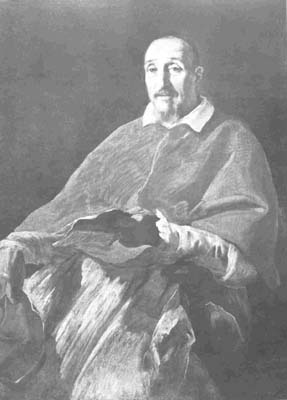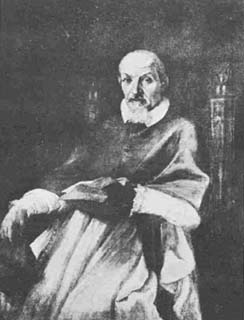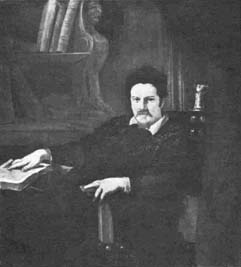
Bulletin 14, 1969
Home
Français
Introduction
History
Annual Index
Author &
Subject
Credits
Contact



Andrea
Sacchi's "Portrait of a Cardinal"
by Ann Sutherland Harris
Résumé en français
Pages 1 | 2
The attribution to Andrea
Sacchi (1599-1661) of the Portrait of a Cardinal in the
National Gallery of Canada (fig. 1), first made in 1924 (1) and
reiterated as recently as 1964, (2) has not seemed satisfactory to a
number of scholars who have suggested a variety of other
attributions. (3) The catalogue of the Gallery prefers caution and
the label "Italian School, 17th Century." (4) The
attribution to Sacchi is, however, certainly correct, and the
painting is, moreover, the only one by this rare master of the
Italian seicento to be seen anywhere on the American
continent. (5)
The correct attribution is far easier to establish than the identity
of the sitter. Research is handicapped by the absence of the
identifying marks common to portraits of this kind, namely
inscriptions on the papers held by the sitter and a coat of arms on
the back of the chair, both clearly visible in Sacchi's portrait of
Cardinal Angelo Giori (fig. 2). Their absence in the Ottawa
portrait, together with the sketchy appearance of most of the
surface, suggests that the picture is unfinished, as does comparison
with Sacchi's portrait of Monsignore Clemente Merlini in the
Borghese Gallery (fig. 3), where only the background is handled
with comparable bravura. In the Ottawa portrait the head alone has
the degree of finish found in Sacchi's other portraits.
A connection with Sacchi is implied by the close similarity of the
composition of the Giori portrait to that of the Ottawa picture. The
former was painted in, or shortly after, 1643; (6) stylistic
parallels for the latter suggest a date around 1630. The latter
seems, in fact, to have served as a modello for the former,
and as the Ottawa portrait is unfinished, it might well have remained in the artist's studio and been available for such use. (7) It
is even possible that the Ottawa picture can be identified with a
portrait of an identified cardinal which is known to have been in
the artist's house in 1661. (8) This portrait is not described as abbozzato
(sketched out) or non finito (unfinished), but then
neither is the portrait of Francesco Albano, now in the Prado (fig.
4), which appears in the same 1661 inventory and of which only the
head has been completed.
There are striking stylistic parallels between the Ottawa portrait
and Sacchi's two sketches for the Collegio Romano fresco of 1629
(fig. 5). (9) The hand of St Ignatius with a book and that of St
Cosmas with an ointment jar should be compared with the left and
right hands respectively of the Ottawa cardinal. The ridged,
textured impasto of the cardinal's left sleeve and of the surplice
below it, crumpled against the arm of the chair, is found again in
the robes of St Ignatius and St Francis of Loyola in the Collegio
Romano sketches, as are very similar drapery forms. The treatment
of the Ottawa cardinal's head can be compared with the heads of
Francesco Albano in the Prado and Clemente Merlini in the Borghese
Gallery (figs. 4, 3). All three have the same vivid and sympathetic
presence of character, while the detailed handling of all the
features, which are drawn with the minimum of fuss, is very close.
The identity of the sitter is less certain than the identity of the
artist. Apart from members of the Barberini family, none of whom
resemble the Ottawa cardinal, there are three cardinals who were old
men in the later 1620s and early 1630s and with whom Sacchi is known
to have had contact. One of these was Cardinal Domenico Ginnasi
(1551-1631), for whom Sacchi worked briefly in 1628. (10) Sacchi is
not known to have painted Ginnasi's portrait, however, (11) and the
resemblance between the Ottawa cardinal and Ginnasi as he appears in
Algardi's portrait in the Borghese Gallery or in Giuliano Finelli's
monument to Ginnasi in Santa Lucia de' Ginnasi is not convincing.
Another possibility is Cardinal Francesco Maria del Monte, who was
Sacchi's chief patron between 1621 and 1626, when he died at the age
of seventy-seven. (12) A portrait of him by Sacchi hung in Sacchi's
front room in 1661 along with portraits of all his other important
patrons. (13) The recent discovery of a portrait drawing of Cardinal
del Monte by Ottavio Leoni (fig. 6), (14) made in 1616, shows that his
features are not those of the Ottawa cardinal, even allowing for the
effects of increased aging in the painting which, for stylistic
reasons, can hardly have been made before 1625-6; (15) consequently
the Ottawa portrait cannot be identified as an image of one of the
most interesting art patrons active in Rome during the seicento. (16)
The remaining candidate is Cardinal Lelio Biscia, a less
influential character than either Ginnasi or del Monte but a man who
nevertheless had an important if small part in Sacchi's career.
Biscia (c. 1573-1638) was Vice-Protector of the Camaldolese Order
and it was almost certainly he who in 1631 commissioned Sacchi's
most famous altarpiece, The Vision of St Romuald, formerly on the
high altar of the Camaldolese church in Rome and now in the
Vatican Picture Gallery. (17) Sacchi certainly painted Biscia, for a
"ritratto (portrait) con il Card. le Biscia" hung in the
same room of Sacchi's house as a small version of the St Romuald
(18) and was presumably painted at about the same time as the
altarpiece. That date - 1631 - also suits the stylistic parallels
for the Ottawa portrait cited earlier. As there is unfortunately no
known record of Biscia's appearance, (19) the identification of the
Ottawa cardinal as Biscia must remain tentative, even though the
circumstantial evidence in favour of Biscia is good.
The unfinished state of the Ottawa portrait may perhaps be
explained by Biscia's circumstances in 1631. After a successful and
honest career in the Vatican bureaucracy in the second decade of the
century, (20) Biscia seems to have made political enemies shortly
after his elevation to the purple in 1626 by seeming too ambitious
to the cliques who decided who was papabile.
As a result he was kept
off the important Congregations and, since he had not enriched
himself during his earlier career, found himself in financial
difficulties compared with his more astute or less scrupulous
colleagues. He was also going deaf. (21) Reading character into a
portrait image is a risky business, but I can see the Ottawa
cardinal as a disappointed and lonely old man who has not entirely
come to terms with his failure to manage Vatican politics to his
own advantage and with his forced early retirement. At all events,
it is a face that engages our sympathy, and perhaps also our pity,
for it hints at the decline in mental powers that comes with old
age. Perhaps Biscia found that he could not afford the portrait
after paying for the altarpiece, and this explains why the
unfinished work remained in the artist's studio and why it served as
a model for the portrait of Cardinal Giori in the 1640s. Still, even
a poor cardinal could probably afford 50 scudi for a portrait. A
better explanation for the picture's unfinished state is that
Sacchi found such an image sufficient for his historic collection of
patron's portraits. For a modern audience, the bravura handling of
the underpaint and the almost Venetian colour scheme, (22) with the
warm red cape set off by the brilliant white surplice, have an
immediate appeal. For students of the seicento, the colour scheme
and technique are also fascinating evidence of the
"baroque" aspects of the artistic character of this
"classical" artist.
Next Page | Notes
1 | 2
Annual Index | Author & Subject | Credits | Contact
This digital collection
was produced under contract to Canada's Digital Collections program,
Industry Canada.
"Digital
Collections Program, Copyright
© National Gallery of
Canada 2001"